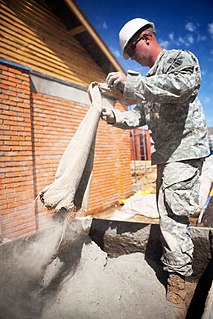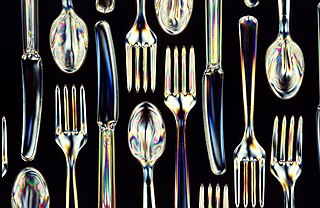
A cement is a binder, a substance used for construction that sets, hardens, and adheres to other materials to bind them together. Cement is seldom used on its own, but rather to bind sand and gravel (aggregate) together. Cement mixed with fine aggregate produces mortar for masonry, or with sand and gravel, produces concrete. Concrete is the most widely used material in existence and is behind only water as the planet's most-consumed resource.

Reforestation is the natural or intentional restocking of existing forests and woodlands (forestation) that have been depleted, usually through deforestation, but also after clearcutting.

Biofuel is fuel that is produced through contemporary processes from biomass, rather than by the very slow geological processes involved in the formation of fossil fuels, such as oil. Since biomass technically can be used as a fuel directly, some people use the terms biomass and biofuel interchangeably. More often than not, however, the word biomass simply denotes the biological raw material the fuel is made of, or some form of thermally/chemically altered solid end product, like torrefied pellets or briquettes.
XPRIZE is a non-profit organization that designs and hosts public competitions intended to encourage technological development to benefit humanity. Their board of trustees include James Cameron, Larry Page, Arianna Huffington, and Ratan Tata among others.
Cellulosic ethanol is ethanol produced from cellulose rather than from the plant's seeds or fruit. It is a biofuel produced from grasses, wood, algae, or other plants. The fibrous parts of the plants are mostly inedible to animals, including humans, except for Ruminants and animals that rely on Hindgut fermentation.
Molding sand, also known as foundry sand, is a sand that when moistened and compressed or oiled or heated tends to pack well and hold its shape. It is used in the process of sand casting for preparing the mould cavity.

The Climate Group is a non-profit organization that works with business and government leaders around the world to address climate change. The group has programs focusing on renewable energy and reducing greenhouse gas emissions. Launched in 2004, the organization operates globally with offices in the UK (headquarters), the United States and India.

Bioplastics are plastic materials produced from renewable biomass sources, such as vegetable fats and oils, corn starch, straw, woodchips, sawdust, recycled food waste, etc. Bioplastic can be made from agricultural by-products and also from used plastics by using microorganisms. Bioplastics are usually derived from sugar derivatives, including starch, cellulose, and lactic acid. Common plastics, such as fossil-fuel plastics are derived from petroleum or natural gas.

Waste-to-energy (WtE) or energy-from-waste (EfW) is the process of generating energy in the form of electricity and/or heat from the primary treatment of waste, or the processing of waste into a fuel source. WtE is a form of energy recovery. Most WtE processes generate electricity and/or heat directly through combustion, or produce a combustible fuel commodity, such as methane, methanol, ethanol. or synthetic fuels.
Sustainable advertising addresses the carbon footprint and other negative environmental and social impacts associated with the production and distribution of advertising materials. A growing number of companies are making a commitment to the reduction of their environmental impact associated with advertising production and distribution.

The Virgin Earth Challenge was a competition offering a $25 million prize for whoever could demonstrate a commercially viable design which results in the permanent removal of greenhouse gases out of the Earth's atmosphere to contribute materially in global warming avoidance. The prize was conceived by Richard Branson, and was announced in London on 9 February 2007 by Branson and former US Vice President Al Gore. However, the prize was never awarded. In 2019, Virgin quietly took the prize website offline, after keeping 11 finalists suspended in expectation for 8 years. Al Gore had withdrawn from the jury earlier and commented that "He was not part of the decision to discontinue the contest.".
Vegetable oil refining is a process to transform vegetable oil into biofuel by hydrocracking or hydrogenation. Hydrocracking breaks big molecules into smaller ones using hydrogen while hydrogenation adds hydrogen to molecules. These methods can be used for production of gasoline, diesel, propane, and other chemical feedstock. Diesel fuel produced from these sources is known as green diesel or renewable diesel.

Sustainable biofuel is biofuel produced in a sustainable manner.
This article is intended to give an overview of the greenhouse gas emissions in the U.S. state of Kentucky.
Bio-energy with carbon capture and storage (BECCS) is the process of extracting bioenergy from biomass and capturing and storing the carbon, thereby removing it from the atmosphere. The carbon in the biomass comes from the greenhouse gas carbon dioxide (CO2) which is extracted from the atmosphere by the biomass when it grows. Energy is extracted in useful forms (electricity, heat, biofuels, etc.) as the biomass is utilized through combustion, fermentation, pyrolysis or other conversion methods. Some of the carbon in the biomass is converted to CO2 or biochar which can then be stored by geologic sequestration or land application, respectively, enabling carbon dioxide removal and making BECCS a negative emissions technology.

Concrete is produced in a variety of compositions, finishes and performance characteristics to meet a wide range of needs.
Sporosarcina pasteurii formerly known as Bacillus pasteurii from older taxonomies, is a gram positive bacterium with the ability to precipitate calcite and solidify sand given a calcium source and urea; through the process of microbiologically induced calcite precipitation (MICP) or biological cementation. S. pasteurii has been proposed to be used as an ecologically sound biological construction material. It is a commonly used for MICP since it is non-pathogenic and is able to produce high amounts of the enzyme urease which hydrolyzes urea to carbonate and ammonia.

The Nationale Postcode Loterij is the biggest charity lottery in the Netherlands. It was founded in 1989 by Novamedia, a marketing agency that sets up and runs charity lotteries. Fifty percent of the proceeds of this lottery are donated amongst 81 charities, which, in 2010 amounted to over 270 million euros.

Microbiologically induced calcium carbonate precipitation (MICP) is a bio-geochemical process that induces calcium carbonate precipitation within the soil matrix. Biomineralization in the form of calcium carbonate precipitation can be traced back to the Precambrian period. Calcium carbonate can be precipitated in three polymorphic forms, which in the order of their usual stabilities are calcite, aragonite and vaterite. The main groups of microorganisms that can induce the carbonate precipitation are photosynthetic microorganisms such as cyanobacteria and microalgae; sulfate-reducing bacteria; and some species of microorganisms involved in nitrogen cycle. Several mechanisms have been identified by which bacteria can induce the calcium carbonate precipitation, including urea hydrolysis, denitrification, sulphate production, and iron reduction. Two different pathways, or autotrophic and heterotrophic pathways, through which calcium carbonate is produced have been identified. There are three autotrophic pathways, which all result in depletion of carbon dioxide and favouring calcium carbonate precipitation. In heterotrophic pathway, two metabolic cycles can be involved: the nitrogen cycle and the sulfur cycle. Several applications of this process have been proposed, such as remediation of cracks and corrosion prevention in concrete, biogrout, sequestration of radionuclides and heavy metals.
bio-bean is a company that has industrialised the process of recycling waste coffee grounds into advanced biofuels, biomass pellets and, in the near future biodiesel.











